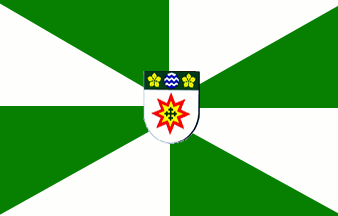 image by Dirk Schönberger,
12 August 2012
image by Dirk Schönberger,
12 August 2012
Last modified: 2021-12-11 by ian macdonald
Keywords: santa catarina | são pedro de alântara |
Links: FOTW homepage |
search |
disclaimer and copyright |
write us |
mirrors
 image by Dirk Schönberger,
12 August 2012
image by Dirk Schönberger,
12 August 2012
The municipality of São Pedro de Alcântara (5,139 inhabtants in 2010; 14,002
ha) is located 30 km west of Florianópolis. The municipality is named for St.
Peter of Alcántara (1499-1562; canonized in 1669 by Pope Clement IX), Brazil's
patron saint.
São Pedro de Alcântara was the first German colony
established in San Catarina, settled on 1 March 1829 by immigrants mostly coming
from Hunsrück and Eifel. The colony was established along a tropeiros' road,
established in 1787, named by the German Kaiserlicher Weg (Imperial Road).
The municipality of São Pedro de Alcântara was established in 16 April 1994.
https://www.pmspa.sc.gov.br/
Municipal website
Ivan Sache, 7 November 2021
Gyronny of green and white, with the municipal shield in the centre.
Official website at
http://www.pmspa.sc.gov.br
Dirk Schönberger,
12 August 2012
The flag of São Pedro de Alcântara is prescribed by Municipal Law No. 53
promulgated on 27 August 1997.
Article 1.
The flag of the
municipality shall have the following heraldic description. Gyronny white and
vert, charged in the center with the municipal coat of arms in full colors and
outlined black.
§1. The arms of the municipality shall be reproduced in the
center of the flag, the outer ornaments (mural crown and scroll) omitted.
Article 2.
The features of the municipal flag shall obey the following
rules.
I - The flag's width shall be 20 units.
II - The flag's length
shall be 28 units.
III - The flag's gyronny field shall be composed of eight
triangles, or gyron. It is obtained by dividing the rectangle by four
rectilinear lines crossing each other in the center, one vertical and one
horizontal and the two other connecting the quadrilateral's angles.
IV - The
first triangle, or gyron, located in the right half of the flag's upper edge,
shall be white, followed by a green gyron, and so on.
V - The field of the
shield shall be composed of a rectangle of 7 units in length on 5 units in
width, in base a semi-circle of 3.5 units in radius.
VI - The shield's
vertical axis shall match the flag's vertical axis.
VII - The distance of
the shield to the flag's upper border, the outline sable excluded, shall be 6
units.
VIII - The points of the star gules (red) and of the star or (yellow)
shall be inscribed in two imaginary concentric circumferences, of 5 units in
diameter and 3.5 units in diameter, respectively.
IX - The common center of
the two circumferences shall be located on the shield's vertical axis 5 units
from its upper edge.
X - The cross crosslet in the shield's center, shall be
inscribed in an imaginary square, of 1.6 unit in side, and whose center shall
match the center of the two circumferences.
XI - The chief shall be 7 units
in length and 2.4 units in width.
XII - The spring shall be inscribed in an
imaginary circumference of 1.8 unit in diameter, whose center shall be located
on the shield's vertical axis, 0.1 unit from its upper edge.
XIII - Each
cinquefoil shall be inscribed in an imaginary circle of 1.9 unit in diameter.
XIV - The center of the circle limiting each cinquefoil shall be located 1.15
unit of the shield's upper edge, on an imaginary line parallel to the vertical
axis, one on the right and the other on the left, 2.4 units from the axis.
XV - The shield's outline sable (black) shall be 0.1 unit in width.
[...]
XVII- The shield's charges and the flag's field shall have bright colors:
a
- vert, matching Veronese green or a similar color.
b - yellow, matching
cadmium yellow or a similar color.
c - azure, matching ultramarine blue or a
similar color.
XVIII - The small star and the two cinquefoils, normally
represented in gold, could be represented in yellow, matching cadmium yellow or
a similar color.
XIX - The field of the shield and, on the spring, the three
fesses argent could be represented in white.
https://leismunicipais.com.br/a/sc/s/sao-pedro-de-alcantara/lei-ordinaria/1997/6/53/lei-ordinaria-n-53-1997-dispoe-sobre-a-forma-e-a-apresentacao-da-bandeira-do-municipio-de-sao-pedro-de-alcantara-e-da-outras-providencias
Leis Municipais database
Ivan Sache, 7 November 2021